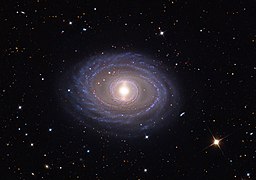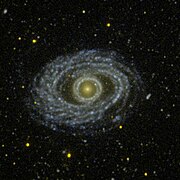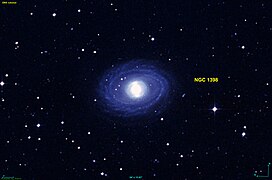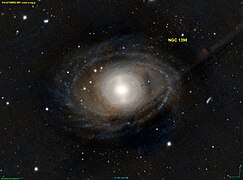NGC 1398
| NGC 1398 | |
|---|---|
 | |
| Observation data (J2000 epoch) | |
| Constellation | Fornax |
| Right ascension | 03h 38m 52.13s[1] |
| Declination | −26° 20′ 16.2″[1] |
| Redshift | 0.004657[1] |
| Distance | 65 million light years[2] |
| Apparent magnitude (V) | 10.63[1] |
| Characteristics | |
| Type | (R')SB(r)ab[1] |
| Apparent size (V) | 7.1′ × 5.4′[1] |
| Other designations | |
| ESO 482-22, PGC 13434[1] | |
NGC 1398 is an isolated barred spiral galaxy exhibiting a double ring structure. It is located 65 million light years from the Earth, in the constellation of Fornax.[2][3] The galaxy, with a diameter of 135,000 light years, is bigger than the Milky Way. Over 100 billion stars are in the galaxy.[4] It was first discovered by Friedrich Winnecke of Karlsruhe, Germany, on 17 December 1868, while he was searching for comets.[5]
One supernova has been observed in NGC 1398: SN 1996N (type Ib/c, mag. 16).[6]
Gallery[edit]
- NGC 1398 from the Mount Lemmon Observatory
- NGC 1398 by GALEX
- DSS image of NGC 1398
- NGC 1398 by Hubble Space Telescope
- NGC 1398 by Pan-STARRS
- The spiral galaxy NGC 1398, which lies roughly 65 million light-years from Earth in the constellation Fornax. [7]
References[edit]
- ^ a b c d e f g "NED results for object NGC 1398". ned.ipac.caltech.edu. Retrieved 17 February 2015.
- ^ a b "NGC 1398". noao.edu. Archived from the original on 9 August 2014. Retrieved 17 February 2015.
- ^ Moore, E. M.; Gottesman, S. T. (1 July 1995). "The Barred Spiral Galaxy NGC 1398 and Its Pattern Speed". The Astrophysical Journal. 447: 159. Bibcode:1995ApJ...447..159M. doi:10.1086/175862. Retrieved 17 February 2015.
- ^ "Dark Energy Survey kicks off second season cataloging the wonders of deep space". fnal.gov. 18 August 2014. Retrieved 17 February 2015.
- ^ Stephen James O'Meara (12 April 2007). Deep-Sky Companions: Hidden Treasures. Cambridge University Press. p. 110. ISBN 978-1-139-46373-7.
- ^ Transient Name Server entry for SN 1996N. Retrieved 30 March 2023.
- ^ "A Galaxy Adrift". NOIRLab. Retrieved 13 October 2021.
External links[edit]
 Media related to NGC 1398 at Wikimedia Commons
Media related to NGC 1398 at Wikimedia Commons


 French
French Deutsch
Deutsch




![The spiral galaxy NGC 1398, which lies roughly 65 million light-years from Earth in the constellation Fornax. [7]](http://upload.wikimedia.org/wikipedia/commons/thumb/4/40/A_Galaxy_Adrift.jpg/252px-A_Galaxy_Adrift.jpg)